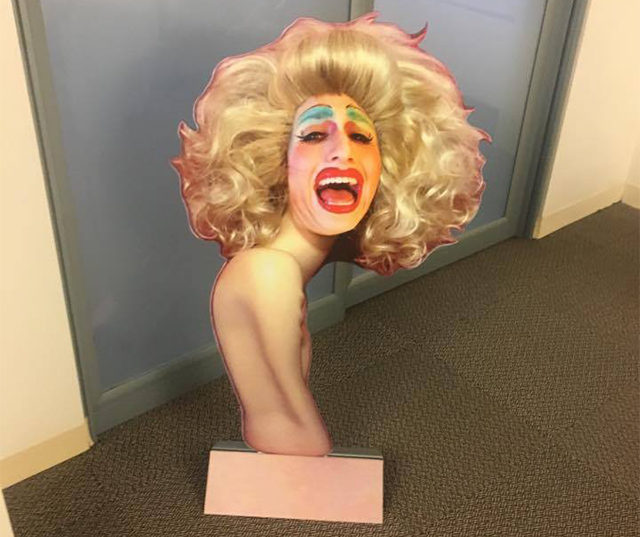
This cut-out from Allison Zuckerman gets a nod for many reasons, but primarily because everyone agrees it looks like AFC editor Michael Anthony Farley, AKA Ellen Degenerate.
What’s on View: Two floors crammed full of art shows assembled by 150 independent curators and responding to the theme of Black Mirror. Said theme, chosen by SPRING/BREAK organizers Andrew Gori and Ambre Kelly, is supposed to be a unifying force, and refers to tools used by old masters for landscape painting and portraiture. What we see, though, is a vast array of approaches ranging from formal painting to DIY barbershops. Some directly respond to theme, others have little to nothing to do with it. Mirrors are everywhere.
Molly: SPRING/BREAK is famous for activating and reframing historic spaces. It’s new home in Conde Nast’s former office building in Times Square is the perfect backdrop for this year’s theme: “Black Mirror.” Claude Glass (or black mirrors) were devices used by Old Masters to abstract reality and isolate subjects in a more pleasing manner. One of the most interesting parts of the fair was seeing how every booth reframed the view of Times Square, transforming a block of the city I usually associate with anxiety inducing amounts of tourists posing with Hello Kitties and Spidermen into various picturesque landscapes. That being said, the former office space was so jam-packed that while the coveted “offices with a view” presented a multitude of compelling shows I felt so drained by the end I couldn’t give them proper attention. I love the notion of reframing a vacant space into a platform for contemporary art but the cubicle spaces didn’t feel abstracted enough to transport me anywhere and I felt overwhelmed by the amount of booths crammed into the space.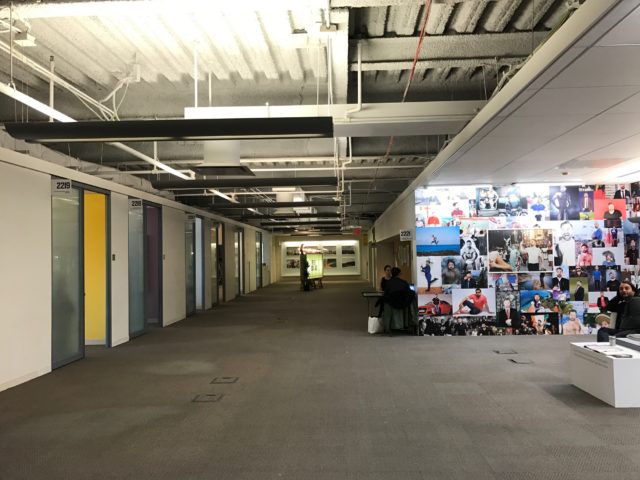
Harrison: From the organizers’ own descriptions on the site, they’re relying heavily on an Oscar Wilde narrative, asking the viewer first, “How does this multiplication of the self [through a black mirror] impact the expressive artifact?” Dorian Gray is pulled into view both through question and direct reference. This year’s suggested readings also include Leigh Bowery—overall introducing an evaluation of personhood through physical investigation and individually created mythologies.
It showed. There were mirrors everywhere and self-referencing or self-obliterating works in many of the booths—which were very densely packed in the space. Honestly each floor is at least a fair’s worth of art, so be ready to map your way through the fair with snacks and water packed.
The Pursuit of It
Curated by Nicole Grammatico and Christina Papanicolaou
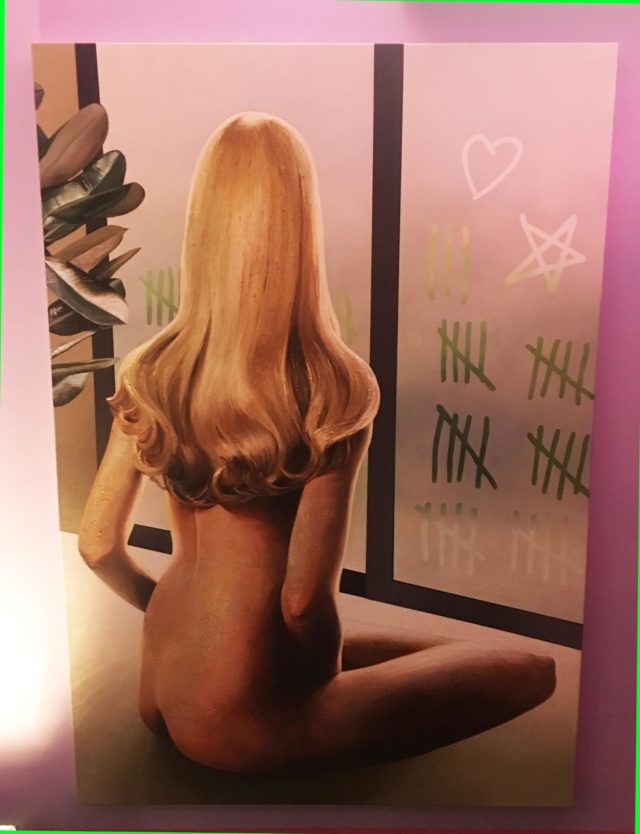
Robin F. Williams
Molly: The bustle of Times Square makes getting into the fair a bit of an ordeal, so I was relieved that one of the first rooms we visited makes you forget about all that. The view of a Manhattan skyline sunset melds perfectly into the hyper femme dreamland of this space. Curated around the idea of a dollhouse, the show gives the artist’s room to play with the ideas of femininity and the demarcation of object and subject—very fitting for the Black Mirror theme.
Robin F. Williams’ painting of a nude woman gazing out a window—on which she has drawn tally marks, juvenile stars, and hearts—was a perfect melancholy opening for the show, setting a tone of beautiful frustration and caged desire.
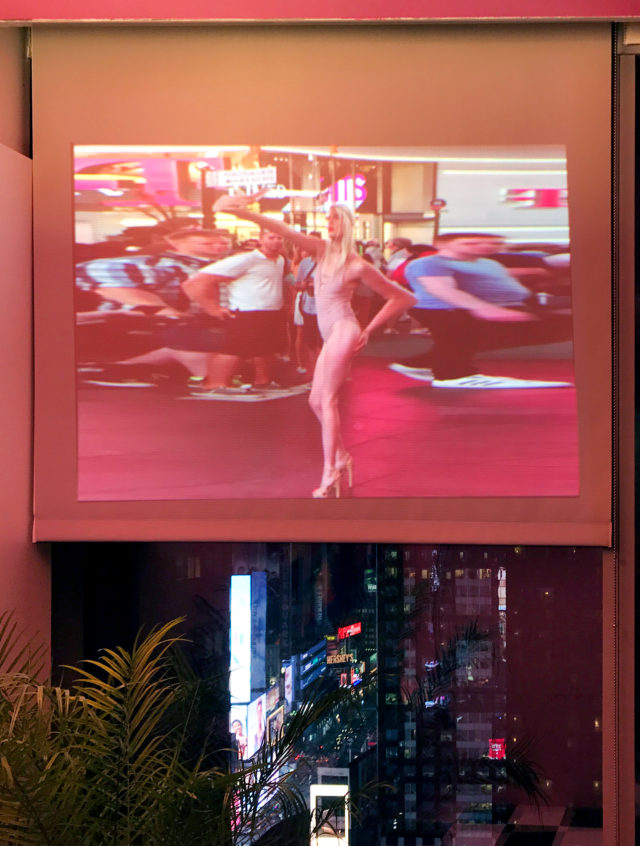
Signe Pierce’s video, projected onto the window at sunset, seemed perfectly at home, a glimpse into the violent nature of the gorgeous view below. In the video, Pierce poses in a unitard, snapping selfies, while we catch distorted glimpses of tourists’ reactions to her body in public space.
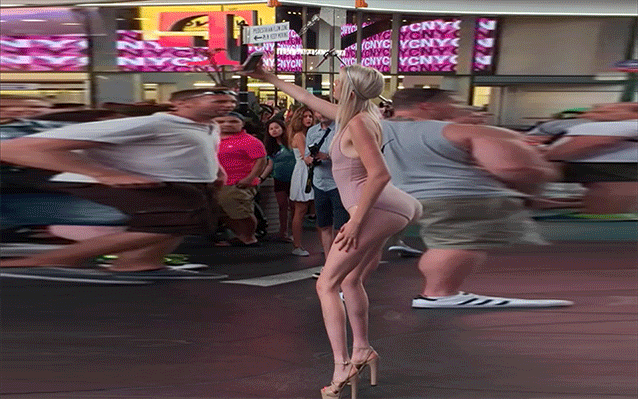
Stills from Signe Pierce’s video
Harrison: This booth is an immersion to your favorite dreamgirl room from your favorite princess fantasy. It’s high-femme. It’s powerful and aggressive in its softness, and a forward display of self-designed femininity. Each artist fulfilled the curatorial goal of imaging a “choose-your-own-adventure” style womanhood, from plushy embroidered cacti (Hein Koh) to a La Danse reference for and by women of color (Hiba Schnabhaz.)
LEAH SCHRAGER: @OnaArtist
Curated by Kristen Sancken
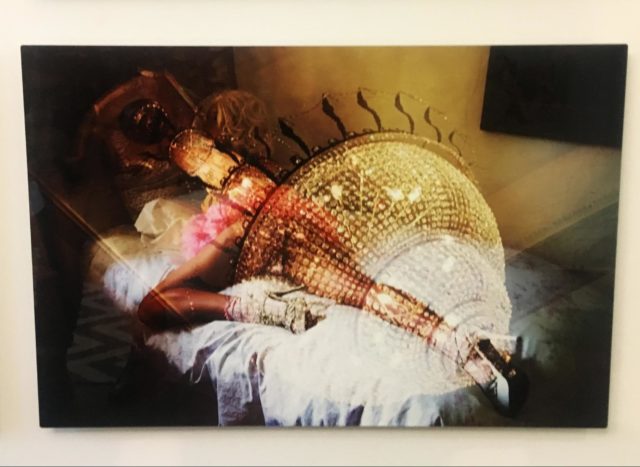
Harrison: Leah Schrager’s work plays heavily with the boundaries of what social media sites deem appropriate for their users to post. Hypersexualized selfies are obstructed by banal images of mid-luxury items or lo-fi glitchwork, just covering enough for her image to be safe for the public. Each image is part of a larger narrative, informing how the viewer consumes her mythology. Schrager works over social media—narrating her own life to suit a celebrity project—and is fully succeeding with a cult following, music releases, and of course exhibitions.
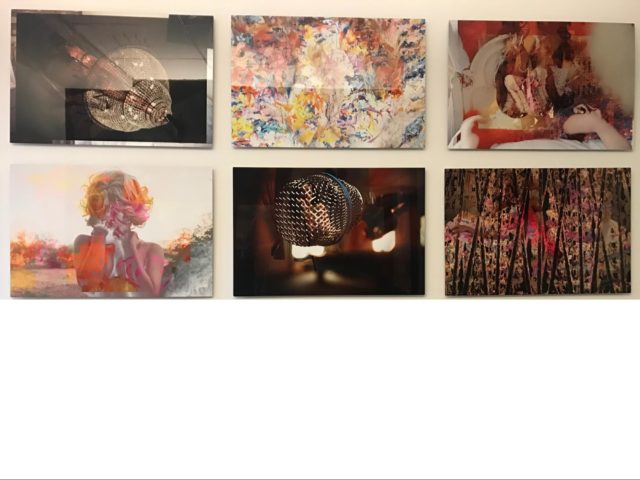
Leah Schrager
Molly: Leah Schrager created her “Ona” (short for online persona) account in the hopes of becoming a social media star and I am definitely one of her 471k fans. The art world often has a puritanical stance on women using their bodies in art and I’ve always appreciated Shrager unabashedly and thoughtfully shoving her sexuality right back in it’s face. This installation featured images of Shrager’s body being overtaken by objects like glitter and chandeliers, playing with the relationship between objects and social media brands.
Ben Sisto, “The Museum of Who Let Dogs Out Out?”
Curated by Jac Lahav

Molly: There is always a booth I walk in and think “I have a crush on this artist” and Ben Sisto’s was it this year. This room featured every piece of merchandise featuring the Baha Men song “Who Let the Dogs Out?” artist Ben Sisto has been able to get his hands on. It was like the ultimate fuck boy fantasy bedroom. Of course it’s the booth I want to marry. There is even a puppy that walks while singing “Who Let the Dogs Out?” We reached this room about 75% into the fair and the humorous collection of stuffed dogs and novelty tees gave me an energy spike I desperately needed. I’m also going to have the Baha Men stuck in my head for days.
HARRISON: It’s genius. Ben Sisto spent 7 plus years of his life researching “Who Let the Dogs Out?” from the song itself back through any and all musical references or influences that allowed the song to exist. The collection includes toys, music, collectors items, and an incredibly thorough explanation to every piece involved. I laughed throughout the space — this level of intense obsession and research on a single subject is my everything.
TAKE US LYING DOWN
Lisa Levy and Paul Gagner
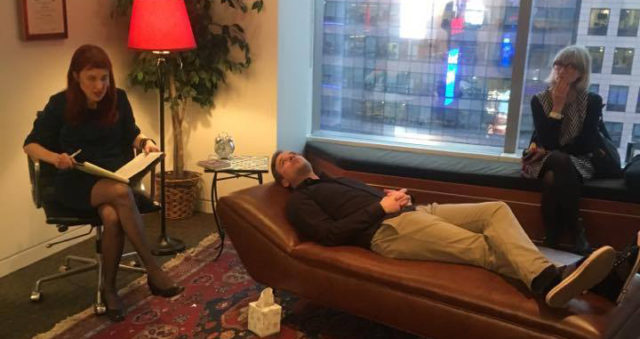
Molly: Spring Break’s office space lended itself perfectly to Lisa Levy and Paul Gagner’s faux therapy office, reception desk and all. While waiting for a therapy session participants are invited to view books written by the fictional Dr. Howard Mosely, M.D., including titles such as A Beginner’s Guide to Home Lobotomy, Coping With Imaginary Foes, and DIY Coffins. Inside the office Lisa Levy gives public therapy sessions in her “office” that includes wall works with statements such as “WOMEN! Lower your expectations of men,” “I don’t know who you are but I need your approval” and various other remarks many of us have experienced our therapist yelling at us. As someone who annoys her therapist weekly, I found the installation charming and relatable. The room felt like an installation I would want to make specifically to troll my own therapist.
ELIZABETH BICK: THE REAL SIN WOULD BE NEVER EXPERIENCING IT
Curated by C. Finley

HARRISON: Elizabeth Bick is a street photography enthusiast, a pastime which introduced her to a stranger on the train. She and this older woman ended up sharing a passion for dance, and collaborated on a series of photos that offer us a glimpse into her life—through illness and hardship, all performed for Bick’s lens. Both Bick and her subject were dancers for years, and their communal understanding of body and movement is evident. Each photograph is incredibly emotive yet quiet and alone, showcasing a performer whose audience is regularly absent.
GUY RICHARDS SMIT
Curated by Carol Bove
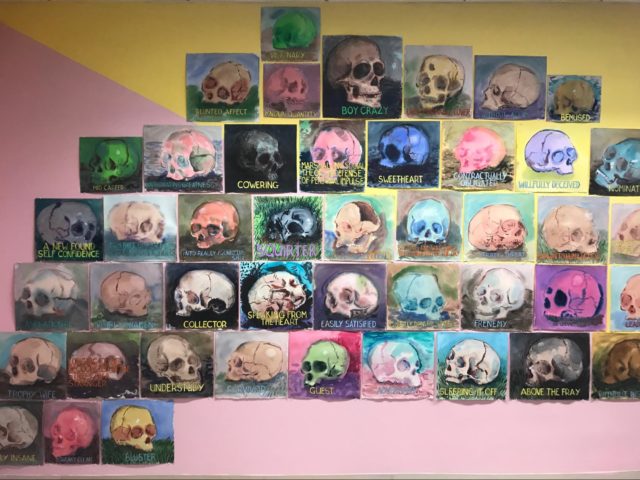
HARRISON: Smit’s series of skull portraits are arranged like a periodic table of descriptors paired with differentiated, but obviously identifiable, skulls. Skull descriptions included words, in all caps, like, “COLLECTOR”, “EASILY SATISFIED”, “BOY CRAZY” and so forth. It’s simple, intelligent, and funny, while also serving as a reminder of mortality. Also Molly and I fit most of the adjectives so we left laughing and directly attacked.
Molly: I felt personally attacked by this booth. I need the large skull with the words “BOY CRAZY” hung over my bed as both a memento mori and a reminder that “actually no, you do not need to send that drunk text.”
SPECIAL PROJECT: GATEWAY by Leah Piepgras
Curated by Grin
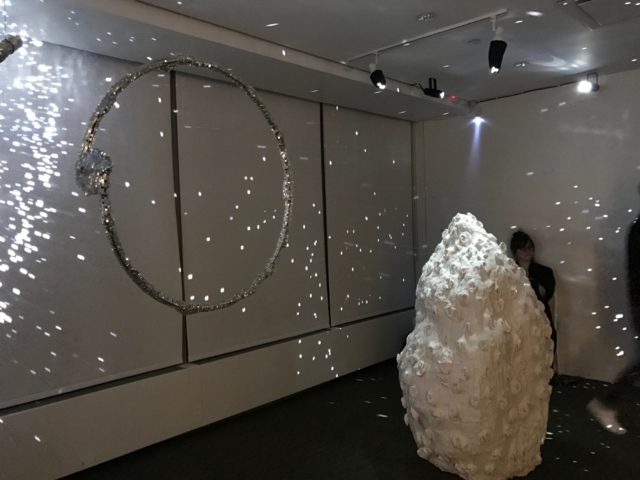
HARRISON: The booth by Providence-based artist run gallery Grin provided the antidote to spiritual and physical fair fatigue. The space is filled with mirrored sculptures lit so the reflected light is soothing and provides blue refraction directly behind the works. The ceiling pieces rotate on their own, while the artist invites viewers to spin the wall works (gently) to create a prayer wheel. I recommend recuperating here.
Molly: Normally if someone told me to “spin a glittery wheel while saying a prayer with good thoughts” my eyes would not be able to roll hard enough but this space was so beautiful I was completely invested. The installation completely transported me and is a perfect room to take a break when art fair fatigue is setting in.



Comments on this entry are closed.